Iran’s pursuit of increasingly sophisticated uranium enrichment technology has advanced significantly in recent decades, with the experimental IR-8 and IR-9 centrifuges representing the pinnacle of the country’s nuclear engineering achievements to date 12. These advanced machines offer substantially greater enrichment capacity than their predecessors, potentially accelerating Iran’s ability to produce highly enriched uranium for either civilian or military purposes 34. The development of these cutting-edge centrifuges marks a significant evolution in Iran’s nuclear program, which began with simple first-generation machines based on designs acquired through the A.Q. Khan network 5.
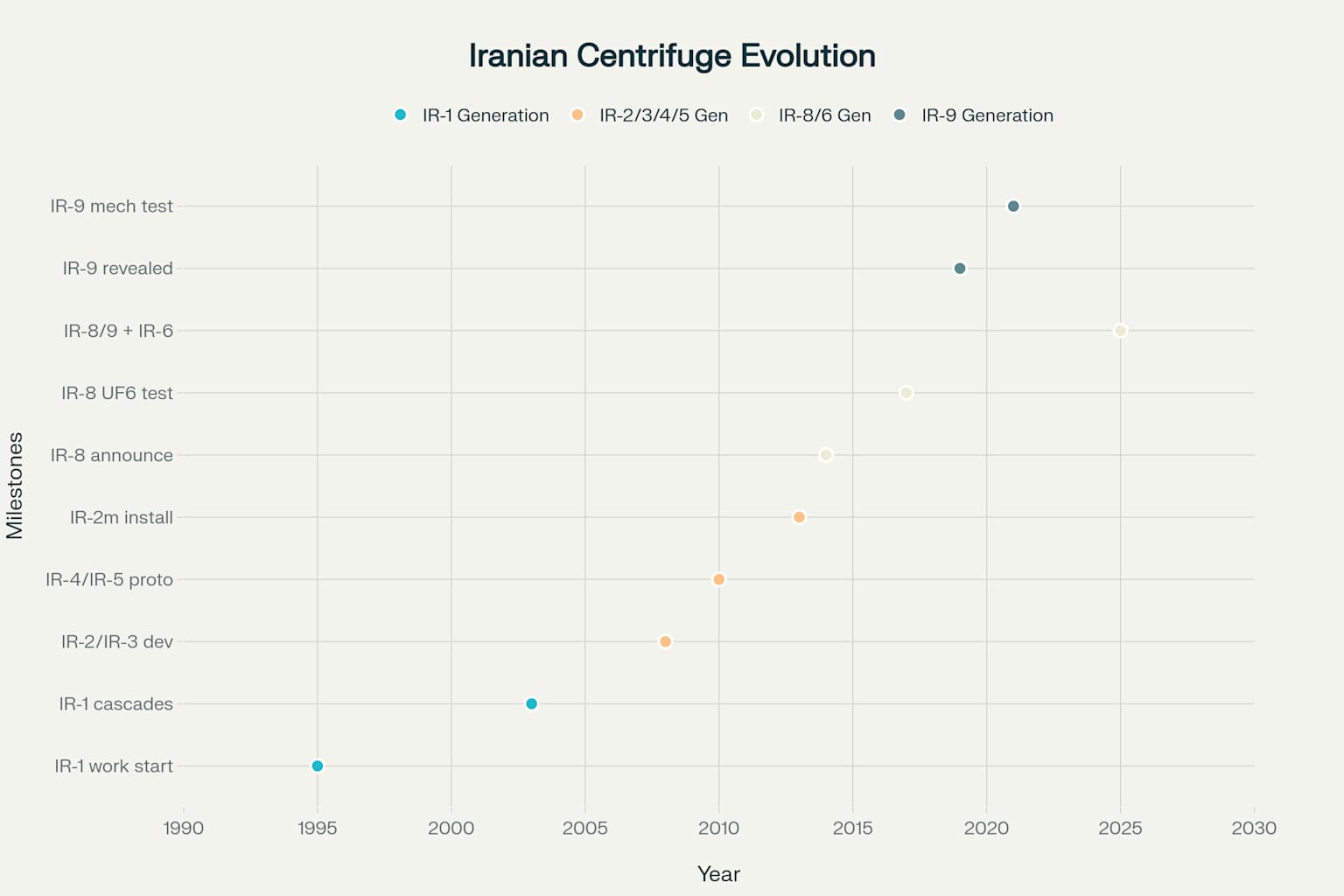
Timeline of Iranian centrifuge technology development (1995-2025)
The Evolution of Iranian Centrifuge Technology
Iran’s centrifuge journey began in 1985 at facilities controlled by the Atomic Energy Organization of Iran (AEOI) in Tehran, initially using technology acquired through what the IAEA termed a “foreign intermediary” 6. The first-generation IR-1 centrifuge, based on Pakistan’s P-1 design, became the workhorse of Iran’s early enrichment efforts despite its relatively modest performance of only 0.8-1.0 Separative Work Units (SWU) per year 78. By late 2007, Iran had commenced feeding uranium hexafluoride gas into approximately 3,000 IR-1 centrifuges installed at its Natanz site, gradually scaling up to over 15,000 machines by 2015 5.
Iran’s centrifuge development accelerated significantly after 2008, with the introduction of second-generation machines like the IR-2m and IR-4, which offered four to five times greater enrichment capacity than the IR-1 48. These advances were followed by the third-generation IR-6 in 2013, which further doubled the enrichment capacity to 10-12 SWU per year 49. This steady progression demonstrated Iran’s growing mastery of increasingly complex centrifuge technology, particularly the shift from aluminum rotors to more advanced carbon fiber components 810.
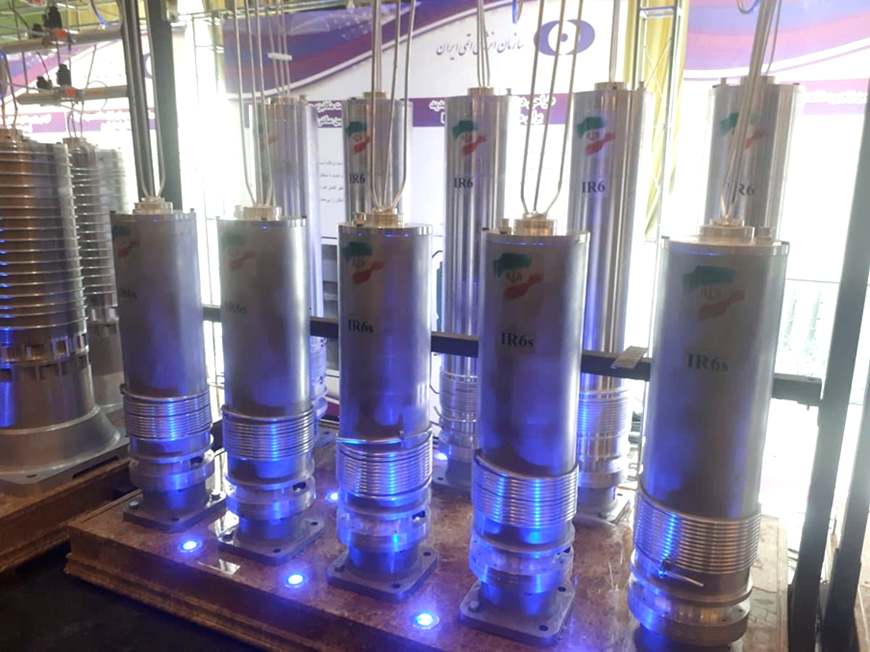
Rows of advanced Iranian IR-6 and IR-6s centrifuges on display, showcasing their design.
The Breakthrough: IR-8 Centrifuge
The IR-8 centrifuge represents a major leap forward in Iran’s enrichment capabilities, with Iranian officials claiming an output of 20-24 SWU per year – approximately twenty times greater than the first-generation IR-1 machines 37. Iran first announced this fourth-generation centrifuge in late 2013, installing an empty casing at the Natanz Pilot Fuel Enrichment Plant (PFEP), possibly to include it under the Joint Plan of Action (JPOA), the precursor to the JCPOA 48. Based on analysis of photographs, the IR-8 is estimated to be between 391 and 396 cm tall, with a casing width of 40 cm, making it substantially larger than earlier models 78.
A critical milestone occurred in January 2017 when Iran began testing the IR-8 with uranium hexafluoride gas, marking the first practical operation of this advanced machine 311. The Atomic Energy Organization of Iran announced this development as “a critical stage in R&D with the advanced generation of IR-8 centrifuges got underway with injection of UF6 gas” 11. Despite these advances, experts have noted that the IR-8 faces significant technical challenges that may limit its practical effectiveness, with one analysis suggesting it “has been a failure” despite initial high expectations 12.
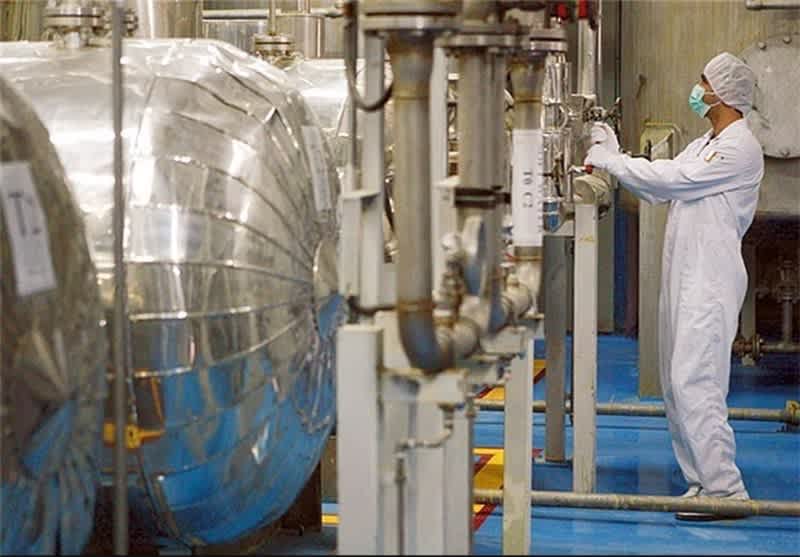
Worker injecting UF6 into IR-8 centrifuges at an Iranian nuclear facility.
The Next Generation: IR-9 Centrifuge
The IR-9 centrifuge, revealed to journalists visiting Natanz in November 2019, represents what may be Iran’s fifth generation of centrifuge technology 47. This imposing machine stands approximately 550 cm tall, making it significantly larger than all previous Iranian centrifuges 78. According to Iranian officials, the IR-9 has a theoretical separation capacity of 40-50 SWU per year, which would make it the most powerful centrifuge in Iran’s arsenal and potentially reduce the number of machines needed for industrial-scale enrichment 713.
In April 2021, Iran announced it had begun mechanical testing of the IR-9 centrifuge, with AEOI spokesman Behrouz Kamalvandi noting that “the output of the IR-9 centrifuge can stand at 50 SWUs – the standard measure of work required to separate uranium isotopes” 1413. This marked a significant advancement, as mechanical testing represents an early but critical phase in centrifuge development before uranium gas is introduced 13. By February 2021, a single IR-9 machine was being tested with UF6 gas, though as of 2025, both the IR-8 and IR-9 remain primarily experimental with only single-digit numbers deployed for testing purposes 715.
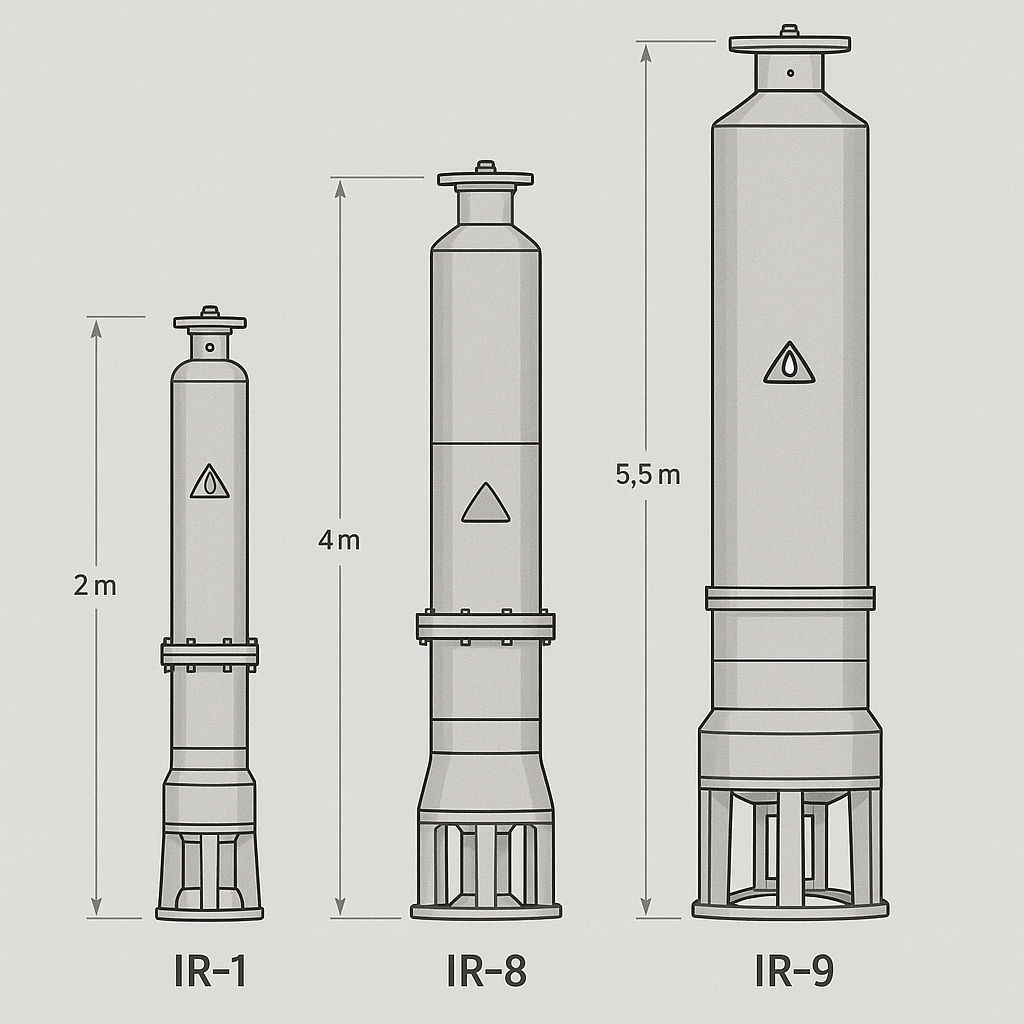
Size comparison of Iranian centrifuge models (IR-1, IR-8, and IR-9) showing the evolution in height and diameter
Technical Design and Materials
Both the IR-8 and IR-9 centrifuges utilize carbon fiber for their rotor assemblies, representing a significant advancement over the aluminum rotors used in the first-generation IR-1 machines 78. Carbon fiber offers several critical advantages for centrifuge construction, including greater strength-to-weight ratio, which allows for faster rotational speeds without rotor failure 1617. Additionally, carbon fiber provides natural insulating properties and corrosion resistance, making these advanced centrifuges more durable and less susceptible to material degradation than their metal-rotor predecessors 1610.
The development of these advanced machines required Iran to master complex manufacturing techniques for precision components, including high-strength rotor tubes, bellows that connect rotor sections, bearings, and molecular pumps 185. Carbon fiber rotors can achieve significantly higher wall speeds – a key determinant of enrichment efficiency – with modern centrifuges reaching peripheral speeds of 700-900 meters per second compared to the approximately 350 meters per second of early designs 198. These technical advancements allow the IR-8 and IR-9 to process uranium gas more efficiently, increasing both throughput and separation potential 8.
How Uranium Enrichment Works
Uranium enrichment is the process of increasing the concentration of uranium-235 (the fissile isotope) relative to uranium-238 (the more common, non-fissile isotope) 2021. Natural uranium contains only about 0.7% U-235, while most nuclear reactors require 3-5% enrichment, and weapons-grade uranium is typically enriched to over 90% 2022. The gas centrifuge has become the dominant enrichment technology due to its relative efficiency and lower energy requirements compared to older methods like gaseous diffusion 2122.
Inside a centrifuge, uranium hexafluoride (UF6) gas is spun at extremely high speeds, creating strong centrifugal forces that cause the slightly heavier U-238 molecules to move toward the outer wall while the lighter U-235 molecules concentrate toward the center 2324. This creates a small separation effect in each individual centrifuge, which is then multiplied by connecting many centrifuges in series (called cascades) to progressively enrich the uranium to desired levels 2522. A single cascade typically contains 164-174 centrifuges, with the more powerful IR-8 and IR-9 models potentially reducing the number of machines needed for the same enrichment output 2625.
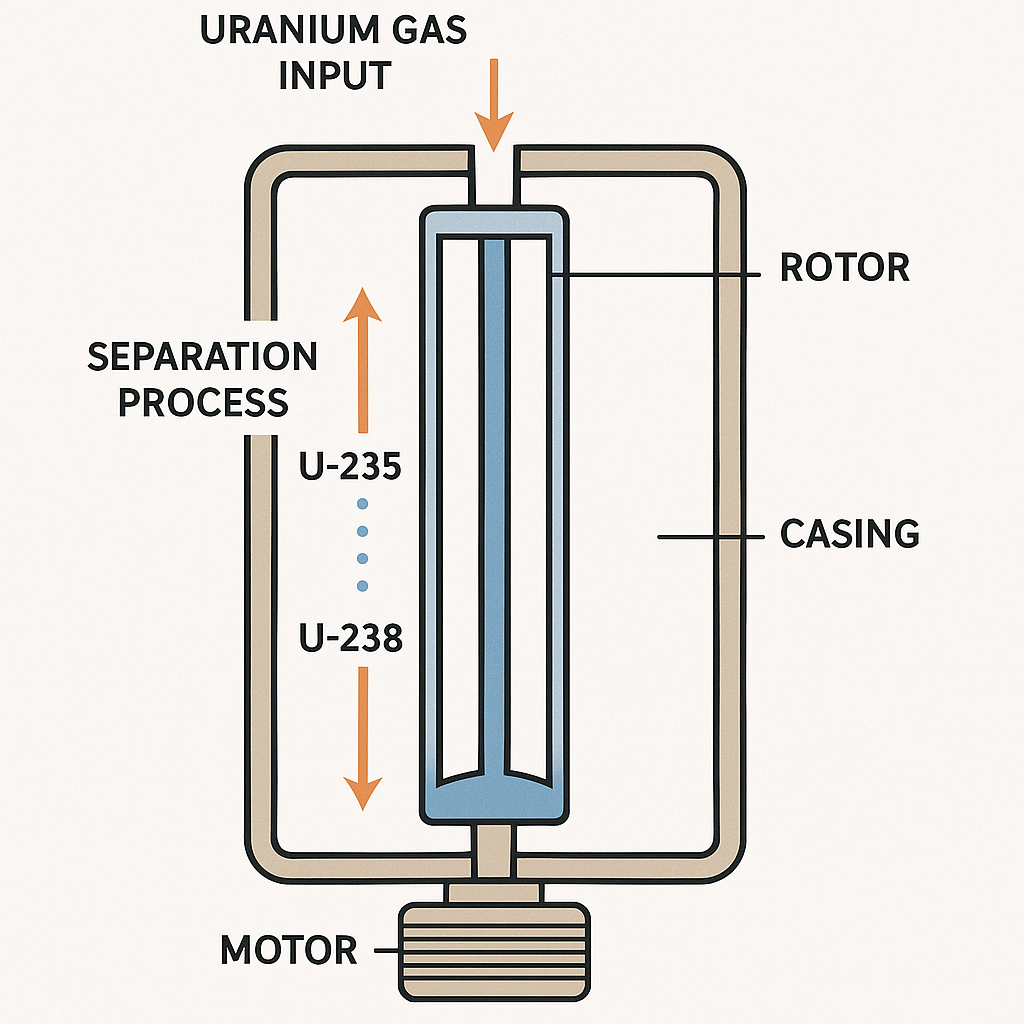
Cross-section diagram of a uranium gas centrifuge showing the separation process of uranium isotopes
Cascade Arrangements and Enrichment Process
No single centrifuge can enrich uranium from its natural state to levels required for nuclear fuel or weapons; instead, multiple machines must be arranged in carefully designed cascades 2527. These cascades are organized with centrifuges in parallel (stages) that are then connected in series, allowing the gas to be progressively enriched as it passes through the system 2518. The enriched stream from each stage feeds into the next higher stage, while the depleted stream is recycled back to lower stages to maximize efficiency 1825.
Iran’s enrichment facilities at Natanz and Fordow contain numerous cascades of different centrifuge models 228. As of 2025, the country was operating 36 cascades of IR-1 centrifuges alongside 42 cascades of more advanced models (including IR-2m, IR-4, and IR-6) at the Natanz Fuel Enrichment Plant (FEP), with additional cascades at Fordow 2930. However, the IR-8 and IR-9 centrifuges have not yet been deployed in full production cascades, with testing limited to single machines or small test cascades 2931.
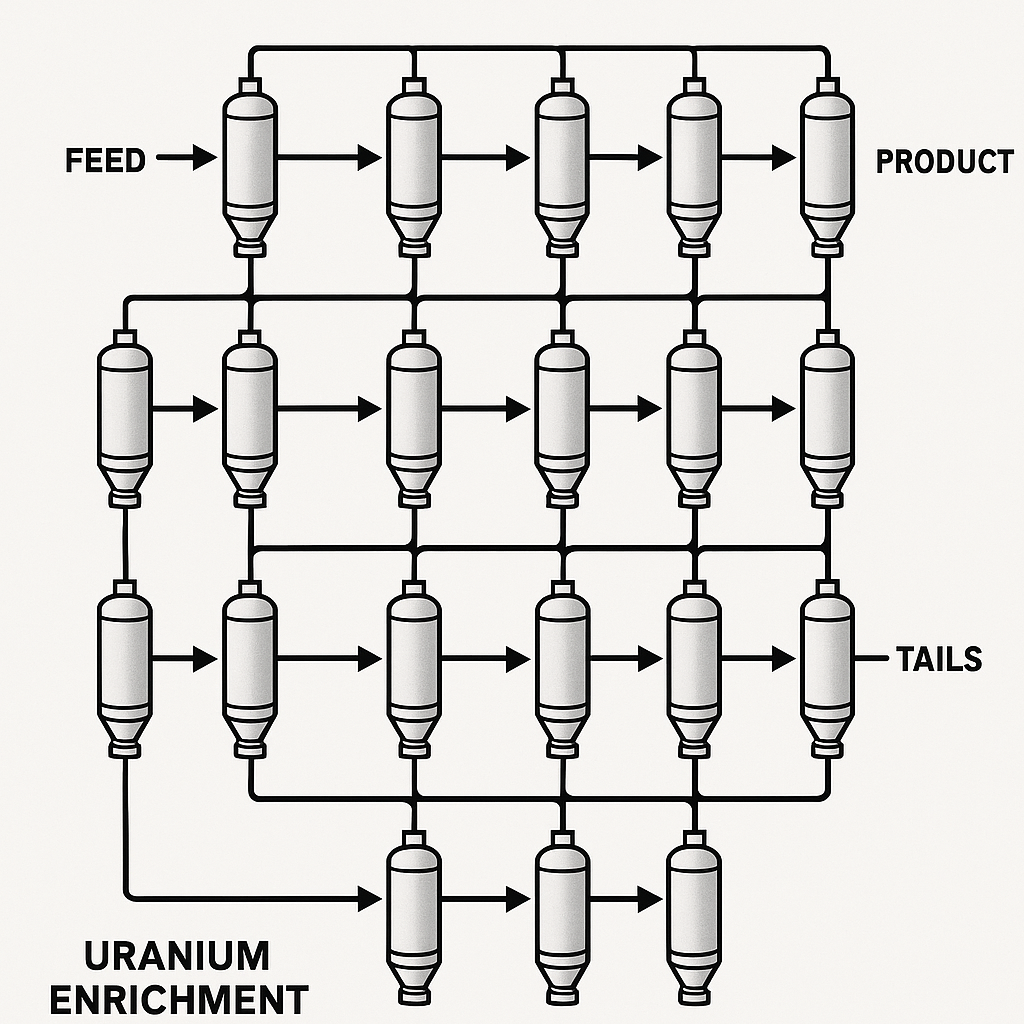
Uranium enrichment cascade layout showing how multiple centrifuges are interconnected to progressively enrich uranium
Performance Reality vs. Claims
While Iranian officials have made ambitious claims about the performance of the IR-8 and IR-9 centrifuges, independent analyses suggest the actual capabilities may fall short of these projections 129. A technical note from the Institute for Science and International Security concluded that “the IR-8 centrifuge is likely far less capable than implied by a literal reading of Iranian statements about enrichment outputs” 1. Similar to the challenges faced with the IR-6, which achieved only about half of its theoretical single-machine value, the IR-8 and IR-9 likely face significant reliability and efficiency challenges in practice 912.
The limitations stem from various factors, including the complexity of manufacturing high-precision components at scale, problems with material quality control, and challenges in operating such advanced machines reliably over extended periods 928. One analysis noted that “Iran’s rapid deployment of many advanced centrifuges in 2019, including many new models, suggests that centrifuge development work continued during the period when the JCPOA was in force,” but that doesn’t necessarily translate to operational success 28. Despite these challenges, the theoretical capabilities of these machines remain concerning to international observers monitoring Iran’s nuclear program 3233.
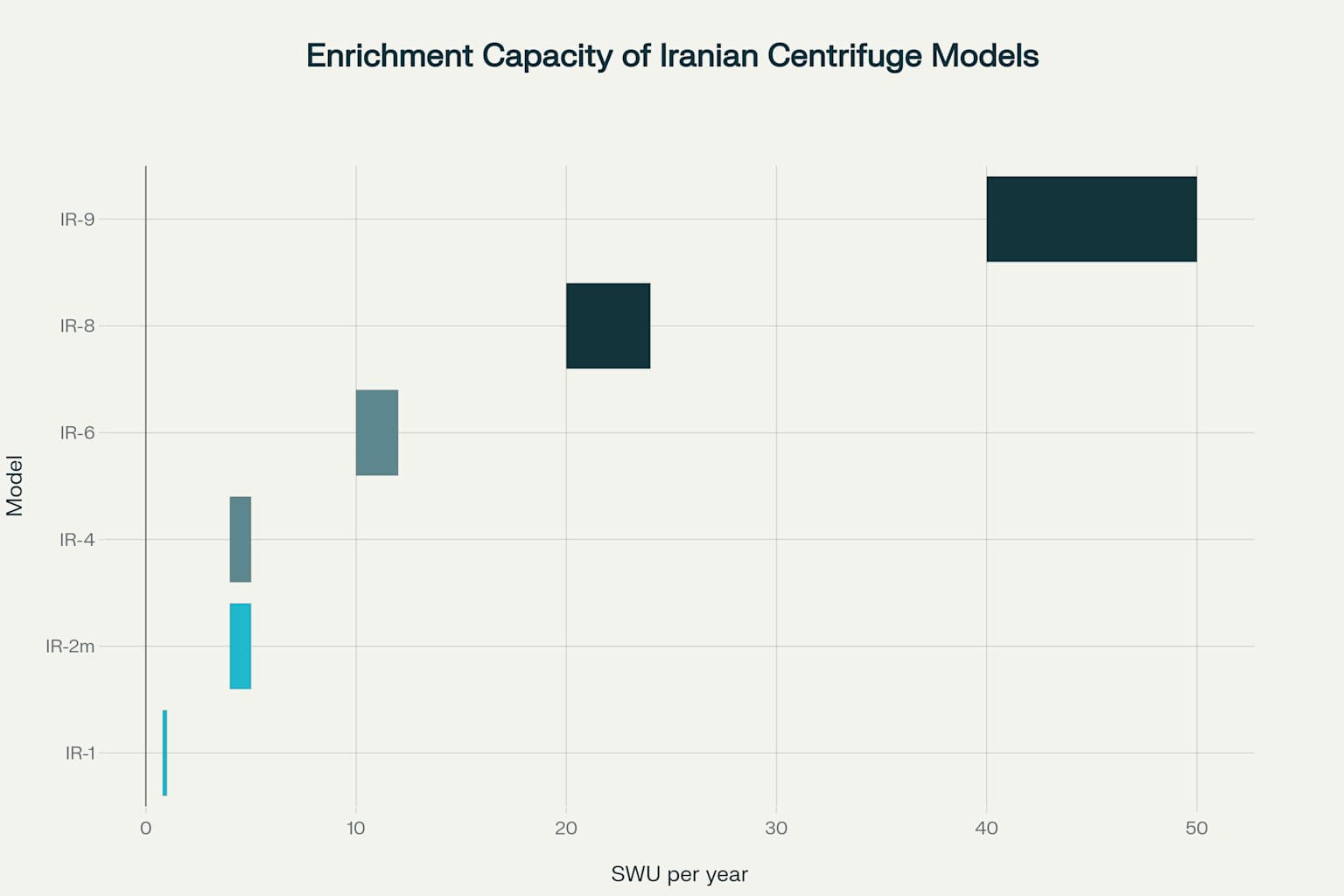
Enrichment capacity comparison of Iranian centrifuge models (from first-generation IR-1 to advanced IR-8 and IR-9)
International Context and Concerns
The development of Iran’s advanced centrifuges has been a major point of contention in international relations, particularly with the United States, Israel, and European powers 3435. Under the 2015 Joint Comprehensive Plan of Action (JCPOA), Iran agreed to limit its uranium enrichment activities, including restrictions on centrifuge research and development 3637. However, following the US withdrawal from the agreement in 2018, Iran progressively abandoned these limitations and accelerated its centrifuge development program 3638.
The international community has expressed serious concerns about Iran’s growing enrichment capacity, particularly as it has begun enriching uranium to 60% purity – a technical step away from weapons-grade levels 3935. In June 2025, the IAEA Board of Governors formally found Iran in non-compliance with its nuclear obligations for the first time in 20 years, a move that Iran condemned as “political” while announcing the opening of a new enrichment facility 4041. This escalation led to Israeli military strikes against several Iranian nuclear facilities in June 2025, specifically targeting enrichment infrastructure at Natanz and other sites 4142.

Global geopolitical context of Iran’s nuclear program showing key international stakeholders
Current Status and Deployment
As of mid-2025, Iran’s deployment of IR-8 and IR-9 centrifuges remains limited to experimental operations rather than full production 1531. According to IAEA verification reports, single units of both models were being tested with natural uranium feed but not accumulating enriched uranium 3143. The IAEA verified in May 2025 that “the following single centrifuges were being tested with natural UF6 but not accumulating enriched uranium: two IR-2m centrifuges; six IR-4 centrifuges; three IR-5 centrifuges; four IR-6 centrifuges; one IR-6s centrifuge; one IR-7 centrifuge; one IR-8 centrifuge; one IR-8B centrifuge; and one IR-9 centrifuge” 43.
Iran’s focus appears to have shifted toward deploying larger numbers of the more mature IR-2m, IR-4, and IR-6 models for production, while continuing research on the more experimental IR-8 and IR-9 designs 2829. This pragmatic approach allows Iran to increase its enrichment capacity in the near term while continuing development of its most advanced models for potential future deployment 1529. Recent Israeli strikes on Iran’s nuclear infrastructure in June 2025 may have further impacted the development timeline for these advanced centrifuges, though the exact extent of damage to research facilities remains unclear 4142.
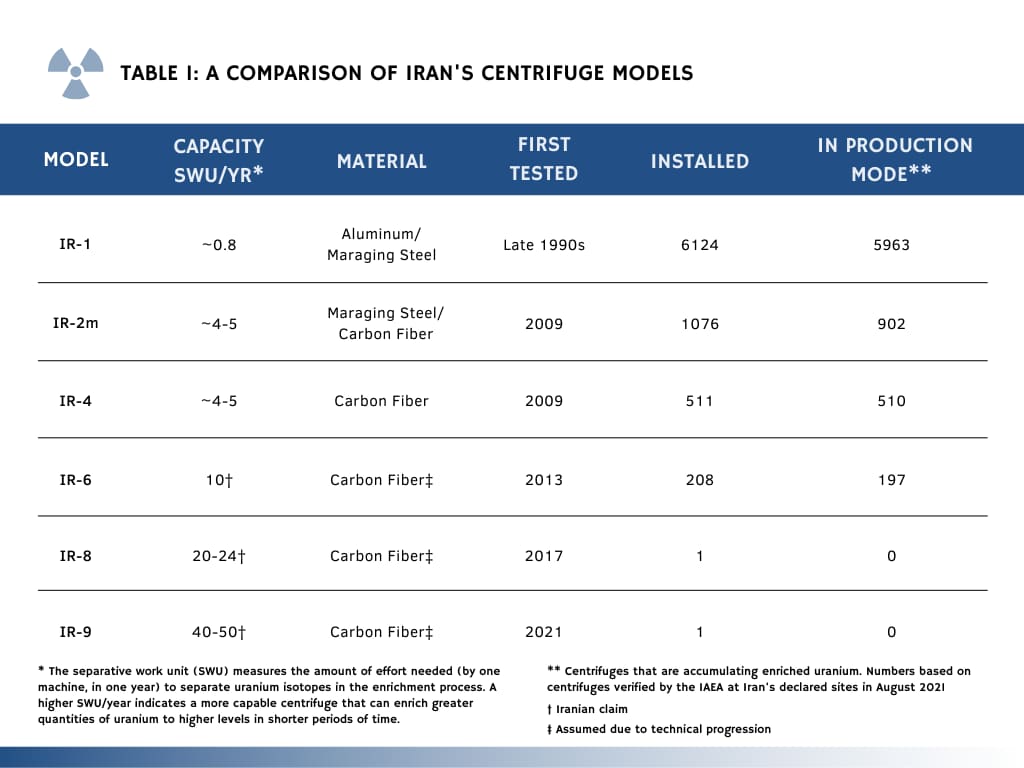
Comparative data on Iran’s centrifuge models, including the advanced IR-8 and IR-9, showing their capacity, materials, and deployment status.
Future Implications
The continued development of Iran’s IR-8 and IR-9 centrifuges has significant implications for both regional security and global nonproliferation efforts 3338. If successfully deployed at scale, these advanced machines could dramatically reduce Iran’s “breakout time” – the period needed to produce enough weapons-grade uranium for a nuclear device 3229. Analysis from the Institute for Science and International Security indicated that Iran’s existing stockpile of highly enriched uranium, combined with its capacity to enrich more at a rapid pace, could allow it to produce enough weapons-grade uranium for about five to six weapons in less than two weeks 38.
Despite the technical challenges facing these advanced centrifuges, the knowledge gained through their development represents an irreversible advancement in Iran’s nuclear capabilities 3236. As noted in one assessment, “Iran has gained valuable technical knowhow, experience, and advancements in the designing and building of its advanced centrifuges. Those gains cannot be reversed or erased, presenting further challenges to the value of seeking to reestablish JCPOA limits” 28. This technological momentum, combined with the recent breakdown in diplomatic efforts, creates a challenging environment for future nonproliferation initiatives 3344.
Conclusion
Iran’s experimental IR-8 and IR-9 centrifuges represent the cutting edge of the country’s uranium enrichment technology, offering theoretical enrichment capacities far beyond earlier models 78. While these advanced machines face significant technical challenges and remain in the experimental phase, they demonstrate Iran’s growing mastery of centrifuge design and manufacturing capabilities 98. The continued development of these technologies, despite international pressure and sanctions, reflects Iran’s determination to advance its nuclear program regardless of external constraints 3436.
As tensions increase between Iran and international powers concerned about its nuclear ambitions, the IR-8 and IR-9 centrifuges stand as powerful symbols of technological advancement and geopolitical defiance 4244. Whether these machines will eventually fulfill their promised potential remains uncertain, but their very existence has already altered the strategic calculus surrounding Iran’s nuclear program and ensured that any future negotiations must account for Iran’s irreversible technological gains 3338. The future of uranium enrichment is indeed faster, and the implications of this acceleration continue to reshape the landscape of global nuclear politics 4438.
Footnotes
-
https://isis-online.org/isis-reports/detail/technical-note-making-sense-out-of-the-ir-8-centrifuge/8 ↩ ↩2
-
https://www.iranwatch.org/our-publications/weapon-program-background-report/irans-centrifuges-models-status ↩ ↩2
-
https://www.world-nuclear-news.org/Articles/Iran-tests-new-generation-centrifuge-under-JCPOA ↩ ↩2 ↩3
-
https://iranprimer.usip.org/blog/2021/nov/22/explainer-controversy-over-iran’s-centrifuges ↩ ↩2 ↩3 ↩4 ↩5
-
https://www.wisconsinproject.org/a-history-of-irans-nuclear-program/ ↩ ↩2 ↩3
-
https://www.iranwatch.org/our-publications/weapon-program-background-report/history-irans-nuclear-program ↩
-
https://www.iranwatch.org/our-publications/articles-reports/beyond-ir-1-irans-advanced-centrifuges-their-lasting-implications ↩ ↩2 ↩3 ↩4 ↩5 ↩6 ↩7 ↩8 ↩9
-
https://www.iranwatch.org/our-publications/articles-reports/explainer-irans-centrifuges ↩ ↩2 ↩3 ↩4 ↩5 ↩6 ↩7 ↩8 ↩9 ↩10 ↩11
-
https://isis-online.org/isis-reports/detail/the-ir-6-centrifuge-needs-further-development/ ↩ ↩2 ↩3 ↩4 ↩5
-
https://assets.thermofisher.com/TFS-Assets/LPD/brochures/fiberlite-centrifuge-rotors-brochure-BRCFGFLROTSOL.pdf ↩ ↩2
-
https://www.tehrantimes.com/news/410533/Iran-starts-testing-IR-8-centrifuges-with-UF6 ↩ ↩2
-
https://isis-online.org/isis-reports/detail/a-note-on-irans-enrichment-claims/8 ↩ ↩2 ↩3
-
https://en.mehrnews.com/news/171762/Iran-testing-advanced-IR-9-centrifuges-AEOI-spox ↩ ↩2 ↩3
-
https://www.cnbc.com/2021/04/10/iran-testing-advanced-nuclear-centrifuge-that-would-allow-faster-uranium-enrichment.html ↩
-
https://isis-online.org/isis-reports/detail/updated-highlights-of-comprehensive-survey-of-irans-advanced-centrifuges/8 ↩ ↩2 ↩3
-
https://assets.thermofisher.com/TFS-Assets/LPD/Application-Notes/fiberlite-rotors-smart-note.pdf ↩ ↩2
-
https://www.laboratorium-apparatuur.nl/amfile/file/download/file/64156/product/10200/ ↩
-
https://world-nuclear.org/information-library/nuclear-fuel-cycle/conversion-enrichment-and-fabrication/uranium-enrichment ↩ ↩2
-
https://geoinfo.nmt.edu/resources/uranium/enrichment.html ↩ ↩2 ↩3
-
https://pubs.aip.org/physicstoday/article/61/9/40/413428/The-gas-centrifuge-and-nuclear-weapons ↩
-
https://programs.fas.org/ssp/nukes/fuelcycle/centrifuges/cascades.html ↩ ↩2 ↩3 ↩4 ↩5
-
https://isis-online.org/uploads/isis-reports/documents/A_Comprehensive_Survey_of_Irans_Advanced_Centrifuges_December_2021.pdf ↩
-
https://commonslibrary.parliament.uk/research-briefings/cbp-10284/ ↩
-
https://isis-online.org/isis-reports/detail/september-2022-highlights-of-survey-of-irans-advanced-centrifuges/8 ↩ ↩2 ↩3 ↩4 ↩5
-
https://www.iranwatch.org/our-publications/articles-reports/irans-nuclear-timetable-weapon-potential ↩ ↩2 ↩3 ↩4 ↩5
-
https://www.iaea.org/sites/default/files/25/06/gov2025-24.pdf ↩
-
https://www.iaea.org/sites/default/files/25/03/gov2025-8.pdf ↩ ↩2 ↩3
-
https://isis-online.org/isis-reports/detail/analysis-of-iaea-iran-verification-and-monitoring-report-may-2025/ ↩ ↩2 ↩3
-
https://www.washingtoninstitute.org/policy-analysis/diplomacy-military-force-future-irans-nuclear-program ↩ ↩2 ↩3 ↩4
-
https://theconversation.com/why-is-there-so-much-concern-over-irans-nuclear-program-and-where-could-it-go-from-here-259052 ↩ ↩2
-
https://www.armscontrol.org/factsheets/restoring-jcpoas-nuclear-limits ↩ ↩2 ↩3 ↩4
-
https://www.hrw.org/report/2019/10/29/maximum-pressure/us-economic-sanctions-harm-iranians-right-health ↩
-
https://iranprimer.usip.org/blog/2025/jan/13/coming-iranian-nuclear-challenge-2025 ↩ ↩2 ↩3 ↩4 ↩5
-
https://www.timesofisrael.com/un-watchdog-says-iran-activated-new-advanced-centrifuges-plans-to-install-more/ ↩
-
https://www.cnn.com/2025/06/14/middleeast/iran-israel-nuclear-facilities-damage-impact-intl ↩ ↩2 ↩3
-
https://www.cnn.com/2025/06/13/middleeast/israel-attack-iran-nuclear-program-explainer-intl ↩ ↩2 ↩3
-
https://isis-online.org/uploads/isis-reports/documents/Analysis_of_May_2025_IAEA_Iran_Verification_Report_FINAL.pdf ↩ ↩2
-
https://en.wikipedia.org/wiki/2025_United_States%E2%80%93Iran_negotiations ↩ ↩2 ↩3